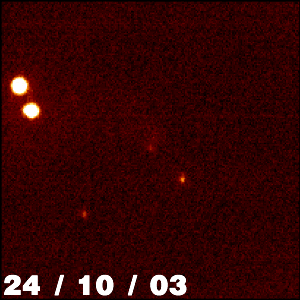
 Copyright © Michael Richmond.
This work is licensed under a Creative Commons License.
Copyright © Michael Richmond.
This work is licensed under a Creative Commons License.
March 09, 2004
Story of a Stellar Eruption
In images taken on Januray 23, 2004 with his small 3 inch telescope,
amateur astronomer J. W. McNeil (USA) noted the appearence of a
new nebulous object near the M78 nebula in Orion. This part
of the sky is an active stellar nursery, where new stars are being born
even today. This unusual object did not appear in much deeper images
obtained at the Palomar Observatory in the 50's and then during the
70's.
In the announcement of this discovery on February 9, 2004, astronomers
suggested that it could be the outburst of a new born star,
illuminating the gas and dust from which it was formed.
This event prompted great interest among both professional and
amateur astronomers worldwide, because less than a dozen of this
eruptions have been witnessed in the past, even thought their are
thought to play a key role in the formation of solar like stars.
By a fortunate coincidence, a team of researchers from the Centro de Investigaciones de
Astronomía (CIDA in Mérida, Venezuela, together
with colleagues at the Smithsonian
Astrophysical Observatory (SAO) in the US, were monitoring since
1999 the part of the sky that included the region were the new nebula
appeared. They used a large
format digital camera installed
on the 1m Schmidt telescope
of Llano del Hato National Astronomical Observatory, located high
in the Venezuelan Andes, to secure an unique sequence of the
eruption.
The team promptly obtained additional observations with telescopes
in the US to better characterize this object. The results of this work,
sent to a refereed journal, indicate that the event responsible for the
appearence of the McNeil nebula is most probably an FU Orionis type of
eruption, in which the gas and dust in an envelope obscuring the star
accrete onto a circumstellar disk, until the pile up of material in the
disk leads to a gravitational instability and the material is dumped
onto the central star in a catastrophic event that releases a huge
amount of energy. This energy produces the large rise in brightness of
the object. The observations obtained from Venezuela show that this
object increased its brightness by a factor of almost 100
compared to its pre-outburst state between 1999 and January 2003, a
behavior characteristic of FU Ori events. The data also indicate that
the eruption started some time between Octiber 28 and November 15,
2003, almost 2 1/2 months before it was detected by McNeil; this shows
the importance of monitoring large areas of the night sky with
sensitive equipment, a type of study that currently can be undertaken
by few instruments around the world, the Venezuela 1m Schmidt with its
panoramic detector is one of
this few facilities that is well posed to explore the time domain in
astrophysical phenomena.
The following image shows an animated sequence of the outburst, constructed from I-band observations obtained between October 24, 2003 and January 26, 2004 with the 1m Schmidt in Llano del Hato. Each image is aprox. 3.5 x 3.5 arcmin (1 arcmin = 1/60 degrees) and is roughly equivalent to 1/10 of the apparent size of the Full Moon on the sky.

 Copyright © Michael Richmond.
This work is licensed under a Creative Commons License.
Copyright © Michael Richmond.
This work is licensed under a Creative Commons License.
 Copyright © Michael Richmond.
This work is licensed under a Creative Commons License.
Copyright © Michael Richmond.
This work is licensed under a Creative Commons License.